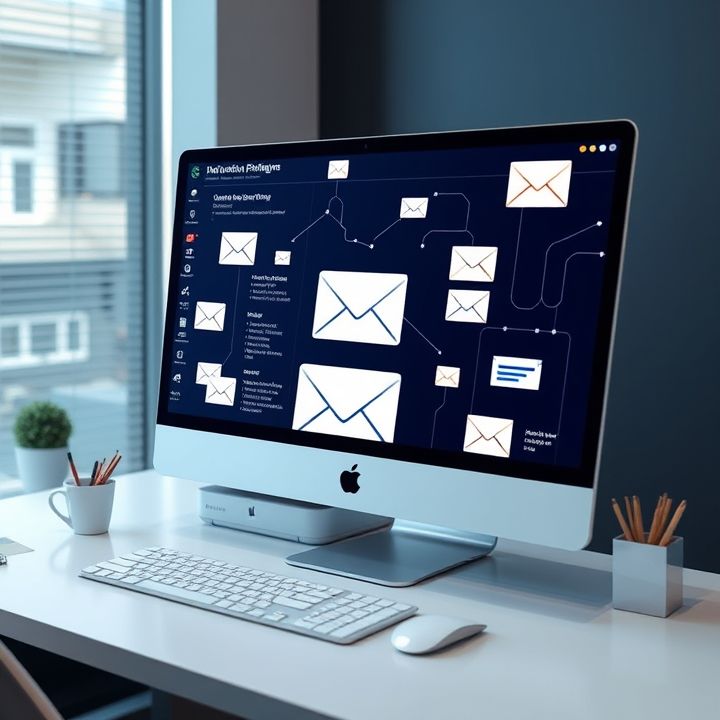Table of Contents
- Introduction
- Segmenting your email list for targeted content
- Using purchase history to tailor product recommendations
- Incorporating geolocation data for relevant offers
- Leveraging behavioral data for personalized timing
- Creating dynamic content based on user preferences
- Utilizing AI and machine learning for predictive personalization
- Incorporating personalized email journeys
- Applying A/B testing to optimize personalization strategies
- Conclusion
- Frequently Asked Questions
Introduction
Email marketing is more than just a buzzword—it’s a potent tool for connecting with audiences in ways that are both engaging and meaningful. Imagine the power of opening an email that truly resonates, not just because it includes your name, but because it taps into your desires and needs.
Beyond the basics of personalized salutations, the real secret to email success lies in the intersection of strategy and execution. But what does it really mean to go ‘beyond the name’? It means crafting messages that speak to the recipient’s unique position in the buyer’s journey, offering them value and incentives tailored precisely to their needs. Discovering this stratagem requires a blend of creativity and analytics—a dance between art and science.
| Key Aspects | Details |
|---|---|
| Personalization | More than just names; it’s about relevance. |
| Strategy | Aligning email content with recipients’ journey stages. |
| Execution | Delivering the right message at the right time. |
Segmenting your email list for targeted content
Segmenting your email list for targeted content is a strategic approach to ensure that your subscribers receive relevant and valuable information. By dividing your list into distinct groups based on specific criteria, you can tailor your messages to meet the unique needs and preferences of each segment. This process begins by analyzing subscriber data to identify key characteristics such as demographics, purchase history, engagement levels, and behavioral patterns.
Once you have identified these segments, you can craft personalized content that resonates with each group. For example, new subscribers may benefit from an introductory series that familiarizes them with your brand, while long-term customers might appreciate exclusive offers or loyalty rewards. Additionally, understanding your segments allows you to time your emails effectively, sending updates or promotions when they are most likely to be opened and engaged with.
Effective list segmentation not only enhances the user experience but also improves engagement rates, as recipients are more likely to interact with content that feels tailored to their interests. As a result, you can expect higher open rates, click-through rates, and conversions, ultimately driving more meaningful connections with your audience.
Using purchase history to tailor product recommendations
Using purchase history to tailor product recommendations is a powerful strategy in email personalization that enhances customer engagement and boosts sales. By analyzing a customer’s buying behavior, businesses can gain insights into their preferences, interests, and needs. This data allows marketers to craft personalized emails that suggest products similar to or complementary with past purchases.
For instance, if a customer recently purchased a smartphone, recommending accessories such as cases or headphones could lead to additional sales. Similarly, if a customer often buys books from a specific genre, suggesting new releases or bestsellers in that genre can capture their attention. By sending these targeted recommendations, companies not only increase the likelihood of purchase but also foster brand loyalty by showing they truly understand their customers.
Moreover, personalized recommendations can be enhanced with algorithms that predict future purchases based on aggregated data trends and individual buying patterns. By leveraging artificial intelligence and machine learning, businesses can refine their product suggestions even further. This approach not only enriches the customer experience but also provides a competitive edge in today’s market where personalized communication is key to customer retention.
Incorporating geolocation data for relevant offers
Incorporating geolocation data into email personalization strategies allows marketers to offer more relevant and timely offers to their audience. By leveraging the geographical location of recipients, businesses can tailor their messaging to match local interests and needs, enhancing engagement and conversion rates.
Geolocation data can help businesses make informed decisions about the types of promotions or content to offer. For instance, a retail chain can send localized offers tailored to the weather conditions of a recipient’s area, such as discounts on winter clothing in colder regions or special deals on sunscreen and swimwear in warmer climates. Furthermore, marketers can notify customers about events or store openings in their vicinity, providing a personal touch that resonates more deeply than generic messages.
Additionally, geolocation data can aid in segmenting audiences based on regional behaviors and preferences. This segmentation enables more precise targeting, ensuring that the right message reaches the right audience at the right time. By understanding local culture and events, businesses can craft messaging that feels personal and timely, ultimately fostering a stronger connection with their audience.
Leveraging behavioral data for personalized timing
Leveraging behavioral data for personalized timing in email marketing is an effective strategy to enhance engagement and conversion rates. Behavioral data refers to the insights gathered from a recipient’s interaction with previous emails, website activity, and purchase history. By analyzing this data, marketers can determine the optimal time to send emails, ensuring they reach the recipient when they are most likely to engage.
For instance, if a customer consistently opens emails late in the evening, scheduling your messages to arrive during this timeframe can increase the likelihood of engagement. Similarly, monitoring the times when customers make purchases or engage with your site can provide valuable clues about when they are most active online.
Beyond just timing, behavioral data helps tailor the content to align with the recipient’s interests and needs. This level of personalization not only enhances the user experience but also encourages stronger brand loyalty. By harnessing the power of behavioral data, businesses can craft more relevant, timely, and engaging email communications, thereby maximizing the impact of their marketing efforts.
Creating dynamic content based on user preferences
Creating dynamic content based on user preferences is an advanced strategy in email personalization that enhances engagement. Instead of sending generic emails, you can tailor each message to fit the recipient’s unique interests and behaviors. This involves leveraging data collected from previous interactions, such as browsing history, past purchases, or even demographic information like age and location. For example, if a recipient frequently browses a particular product category on your website, the emails they receive can highlight similar products or offer exclusive deals related to their interests.
Another approach is using responsive design to create content that adjusts based on user device preferences, ensuring an optimal viewing experience. Segmenting your email list based on user activity or preferences allows you to craft targeted campaigns that speak directly to each group’s interests. Moreover, incorporating dynamic fields in your emails, such as location-specific weather updates or personalized product recommendations, can enhance relevance and effectiveness.
Utilizing machine learning algorithms can also provide deeper insights into user preferences, enabling predictive content that anticipates recipient needs. This level of personalization not only boosts engagement rates but also fosters a stronger connection between the brand and the consumer by making communication feel more personalized and relevant.
Utilizing AI and machine learning for predictive personalization
Utilizing AI and machine learning for predictive personalization in email marketing is a game-changer for businesses seeking to enhance customer engagement. These advanced technologies analyze vast amounts of data to predict customer behavior and preferences, allowing for highly targeted and personalized content. By leveraging machine learning algorithms, marketers can identify patterns and trends in consumer interactions, such as purchase history, browsing behavior, and response to previous campaigns.
This data-driven approach enables businesses to craft emails that resonate more specifically with individual recipients. For example, AI can personalize product recommendations based on a user’s previous interests, increasing the likelihood of conversion. Additionally, predictive analytics can optimize send times, ensuring emails land in the recipient’s inbox at the most opportune moments.
Moreover, AI’s ability to segment audiences dynamically facilitates a more tailored approach, where content can be adapted in real-time to suit changing customer needs and preferences. By embracing these technologies, businesses can forge stronger connections with their audience, ultimately driving engagement, loyalty, and revenue growth. The integration of AI in predictive personalization not only streamlines marketing efforts but also delivers a more meaningful and relevant experience to each recipient.
Incorporating personalized email journeys
Incorporating personalized email journeys involves creating a customized experience for each recipient based on their previous interactions, preferences, and behavior. This approach goes beyond just addressing the recipient by name and aims to engage them more deeply by delivering relevant and timely content tailored to their unique needs. Start by segmenting your audience into smaller groups based on criteria such as purchasing behavior, engagement levels, or demographic information. This segmentation allows for more targeted messaging that resonates with each group’s specific interests.
Another effective strategy is to use dynamic content within your emails. Dynamic content allows different sections of an email to change based on the recipient’s profile, ensuring they receive the most pertinent information. Additionally, leveraging behavioral triggers can enhance personalization. For example, if a customer abandons their cart, sending a follow-up email with a special offer or reminder can encourage them to complete their purchase.
Moreover, the timing of your emails is crucial. Use data analytics to determine when your recipients are most likely to open their emails and adjust your sending times accordingly. By crafting personalized email journeys, businesses can build stronger relationships with their audience, increase engagement, and ultimately drive higher conversion rates.
Applying A/B testing to optimize personalization strategies
When it comes to email personalization, A/B testing is a powerful tool that can significantly enhance your strategies. A/B testing involves sending two variations of an email to a small segment of your audience to determine which version performs better. By applying this method to personalization strategies, you can refine your approach beyond simply adding the recipient’s name. For instance, you can test different subject lines that reference the recipient’s past purchases or interests to see which generates higher open rates. Additionally, experimenting with the timing and frequency of emails can help determine when your audience is most responsive.
Another area to explore is content personalization. You can use A/B testing to assess the impact of tailored recommendations or offers based on user behavior or preferences. By analyzing which type of content or offer drives more engagement, you can better align your messages with your audience’s needs and interests. Furthermore, testing the tone and style of your emails can reveal insights into the kind of language that resonates most. Overall, A/B testing is essential for continuously optimizing your email personalization strategies, ensuring you deliver the right message to the right person at the right time.
Conclusion
In conclusion, mastering the art of email personalization requires going beyond the simple inclusion of a recipient’s name. By delving into various data-driven strategies such as segmenting your email list, analyzing purchase history, and leveraging geolocation data, businesses can deliver tailored content that resonates with every subscriber. Incorporating dynamic content, behavioral insights, and AI-driven predictions further enhances this personalized approach.
These techniques are not merely about improving open and click-through rates. Instead, they focus on forging genuine connections and building long-term relationships with the audience. Personalized email journeys and A/B testing ensure that the right message reaches the right person at the right time, optimizing engagement and conversion.
The transformative power of email personalization lies in its ability to deliver value and relevance, making recipients feel understood and valued. As businesses continue to innovate and refine their strategies, they will discover that true email success comes from a commitment to creating meaningful, personalized experiences that cater to the unique preferences of every customer.

